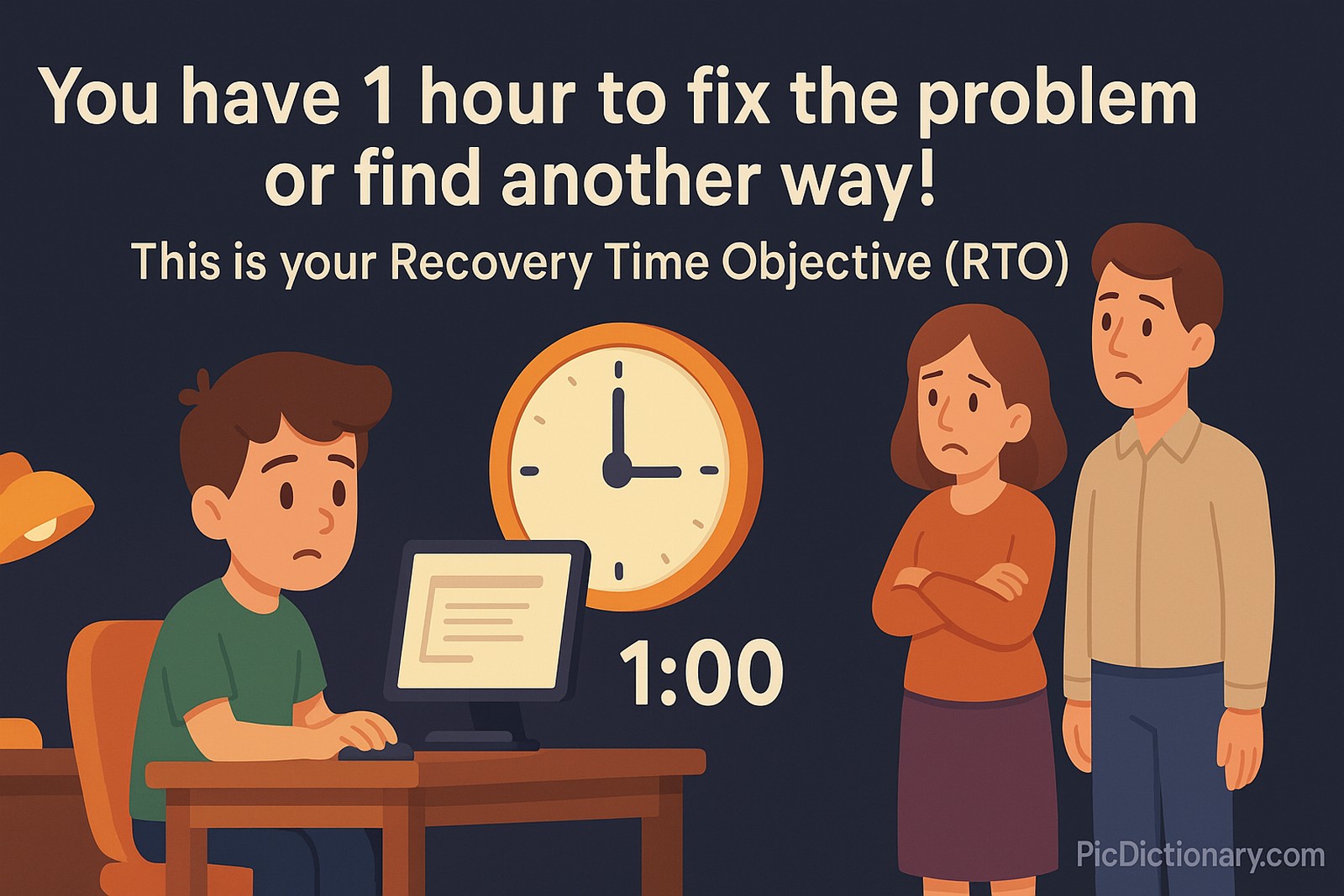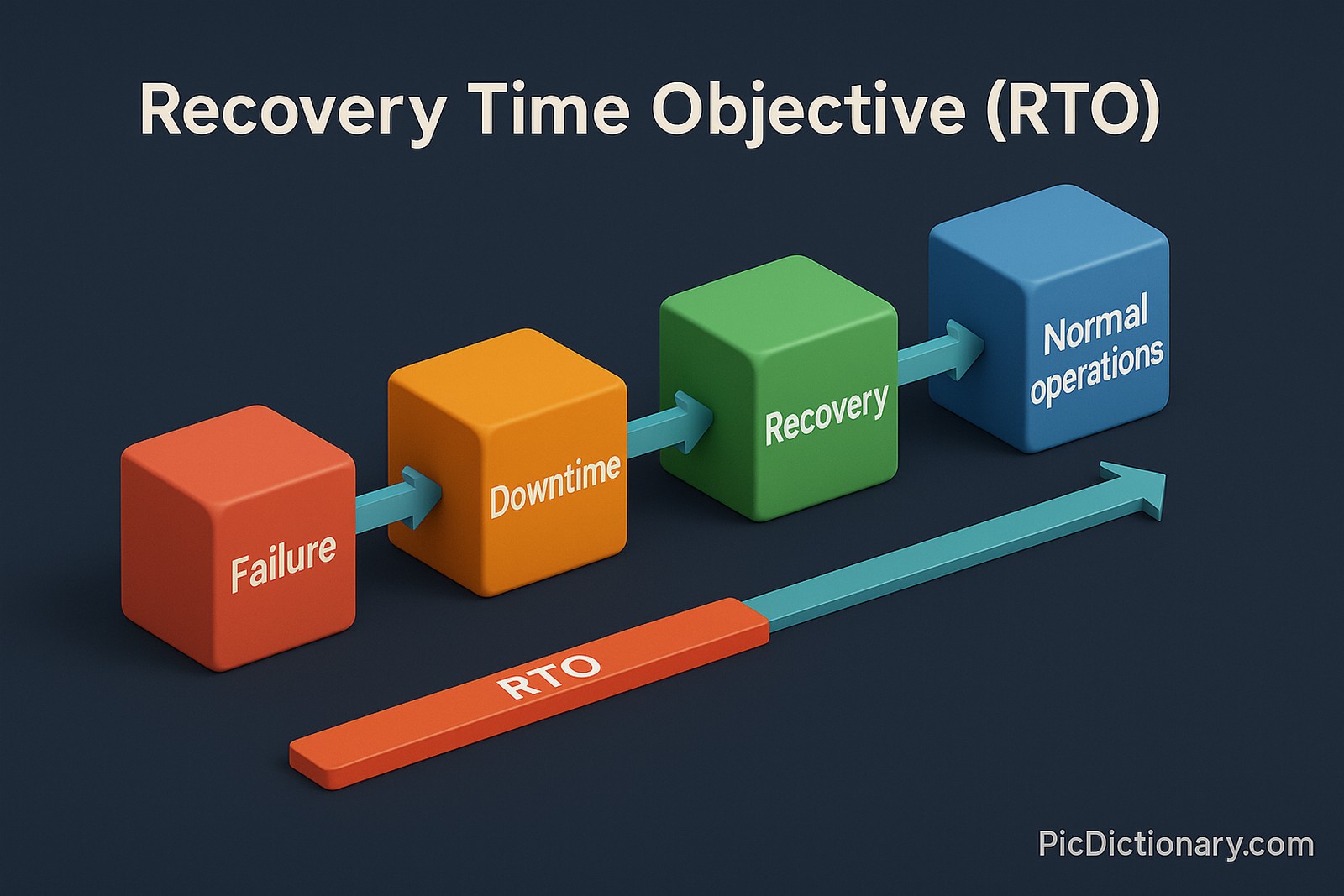Recovery Time Objective (RTO)

Quick Navigation:
- Recovery Time Objective (RTO) Definition
- Recovery Time Objective (RTO) Explained Easy
- Recovery Time Objective (RTO) Origin
- Recovery Time Objective (RTO) Etymology
- Recovery Time Objective (RTO) Usage Trends
- Recovery Time Objective (RTO) Usage
- Recovery Time Objective (RTO) Examples in Context
- Recovery Time Objective (RTO) FAQ
- Recovery Time Objective (RTO) Related Words
Recovery Time Objective (RTO) Definition
Recovery Time Objective (RTO) is the maximum acceptable length of time that a computer system, application, or process can be down after a failure or disruption before significantly impacting business operations. It determines the deadline for recovering systems to a functional state and is a crucial parameter in disaster recovery and business continuity planning. An effective RTO helps organizations prioritize restoration efforts and allocate resources to minimize downtime and prevent data loss.
Recovery Time Objective (RTO) Explained Easy
Imagine you’re doing homework on your computer and the power goes out. Your parents say you have 1 hour to fix the problem or finish your work in another way before they get upset. That 1 hour is like the RTO — it’s the maximum time allowed to fix things and keep everything on track.
Recovery Time Objective (RTO) Origin
The concept of Recovery Time Objective (RTO) originated with the development of disaster recovery practices in IT and business continuity management in the 1970s and 1980s. As systems became more critical to operations, defining the time limits for recovery became essential.
Recovery Time Objective (RTO) Etymology
The word "recovery" refers to the process of returning to a normal state, while "objective" denotes a measurable goal or target.
Recovery Time Objective (RTO) Usage Trends
Over recent decades, RTO has become a key term in risk management and IT disaster recovery planning. With increasing dependence on digital systems, organizations have lowered their acceptable RTOs, sometimes demanding near-zero downtime. Cloud services and high-availability systems are often designed with strict RTOs in mind to meet operational needs.
Recovery Time Objective (RTO) Usage
- Formal/Technical Tagging:
- Disaster Recovery
- Business Continuity
- Risk Management - Typical Collocations:
- "RTO requirements"
- "achieve RTO"
- "disaster recovery RTO"
- "define RTO policy"
Recovery Time Objective (RTO) Examples in Context
- After a server failure, the IT team worked quickly to restore services within the company’s 2-hour RTO.
- Disaster recovery plans must include both RTO and RPO (Recovery Point Objective) specifications.
- The organization invested in redundant systems to meet a strict RTO of 30 minutes.
Recovery Time Objective (RTO) FAQ
- What is Recovery Time Objective (RTO)?
It is the maximum acceptable downtime after a disruption before business impact becomes severe. - How is RTO different from RPO?
RTO refers to time allowed for recovery, while RPO focuses on the acceptable amount of data loss measured in time. - Why is RTO important?
It helps organizations plan and prioritize recovery efforts to reduce business impact during disruptions. - Can RTO be zero?
In theory, yes. Zero RTO means no downtime is acceptable, but achieving this requires highly available systems. - Who sets the RTO?
Business leaders and IT professionals collaboratively define RTOs based on operational needs and risk assessments. - How is RTO calculated?
It’s determined by analyzing system criticality, business impact analysis, and stakeholder input. - Is RTO part of IT compliance standards?
Yes, many compliance frameworks require organizations to define and document their RTOs. - How do cloud services affect RTO?
Cloud infrastructure often allows for reduced RTOs through redundancy and failover systems. - What happens if RTO is not met?
Exceeding RTO can lead to operational disruption, financial loss, and reputational damage. - Does every system have the same RTO?
No, RTOs differ based on system criticality and business needs.

Recovery Time Objective (RTO) Related Words
- Categories/Topics:
- Disaster Recovery
- Business Continuity Planning
- IT Resilience
Did you know?
The concept of RTO gained prominence after major IT disruptions like the 1980 AT&T network outage, which led companies to formalize recovery policies and set clear recovery time objectives to avoid future catastrophic downtime.
Authors | Arjun Vishnu | @ArjunAndVishnu

PicDictionary.com is an online dictionary in pictures. If you have questions or suggestions, please reach out to us on WhatsApp or Twitter.
I am Vishnu. I like AI, Linux, Single Board Computers, and Cloud Computing. I create the web & video content, and I also write for popular websites.
My younger brother, Arjun handles image & video editing. Together, we run a YouTube Channel that's focused on reviewing gadgets and explaining technology.
















Comments (0)
Comments powered by CComment